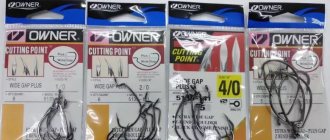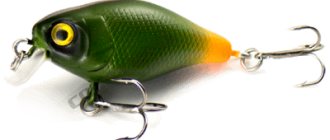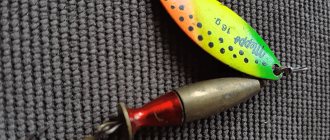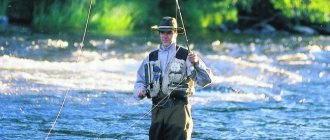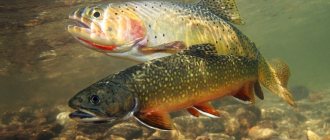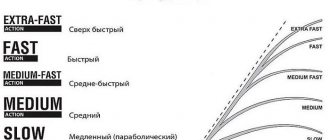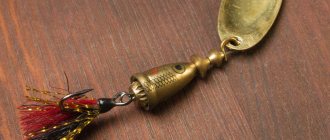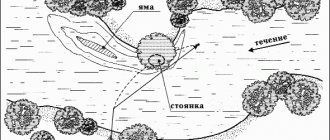A simple way to make jerks with your own hands
Jerks are the best bait for pike fishing.
Due to the simplicity of the design of such bait, many fishermen prefer to make them themselves. This is a fairly simple process that does not require special skills, and all the necessary materials can be found even at home. The article will focus on this type of jerk, which has a zigzag game, reminiscent of the movement of a snake. Materials and tools: - beech strip (thickness 18 mm); - cardboard and pencil (to create a template); - hacksaw, jigsaw; - vice; - file; — grinding machine; - lead (for melting), tin can; - pliers, wire cutters; - hooks, winding rings, wire for creating loops; - paint, mesh, brush and other painting supplies.

Manufacturing process
Step one. Create a template
First you need to create a template; it will be used in the manufacture of all subsequent baits. To create a template, the future blank must be drawn on cardboard and then cut out. You also need to determine in advance where to install hooks and weights.
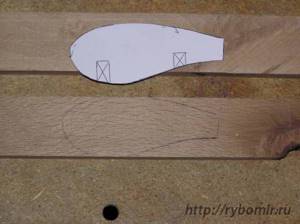
Step two. Cutting out the blank
After the template is created, it needs to be traced on the rail with a pencil and cut out.
The choice of wood is of great importance here, since the performance of the bait will depend on this parameter. In addition, wood differs in density and this will be an important point when loading. The author uses beech as a material. After the workpiece is cut, it should be carefully processed, removing sharp edges.
This is done in a vice using a file. At the end, the workpiece is ground on a machine, achieving maximum smoothness. Step three. Loading bait
Loading is the most important point when creating jerks. The performance of the bait will largely depend on this parameter. Lead can be distributed in different ways, the weight can be concentrated in one part of the jerk or in several. The necessary game of bait is achieved experimentally. For example, if you place two weights at large distances, the bait will have a very sharp and wide amplitude of play.
If the weight is installed in the bow, the bait will become more gliding and the deviations will become longer. Also, by manipulating the locations of the weights, you can establish the “diving” ability of the jerk.
For loading, holes of a suitable size are drilled in the abdominal part of the bait; it is important that they are symmetrical. The load must be clearly in the center of the jerk axis.
To drill the bait to the desired depth, you can stick a piece of adhesive tape or electrical tape onto the drill. Now you need to melt the lead and pour it into the drilled holes. To prevent the workpiece from burning, the wood can be moistened.
Ultimately, excess lead is removed, and the place where the sinkers are installed is carefully sanded with sandpaper.
Step four. Impregnation with varnish, installation of hinges and painting
To protect the bait from moisture, it must be impregnated with varnish. To do this, jerky is boiled for about 3 minutes in varnish and dried.
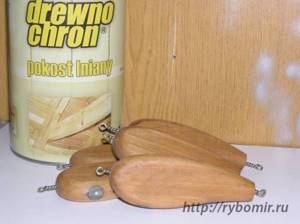
After this, you can make loops for attaching hooks. Steel wire 1.2 mm thick is perfect for these purposes. You should twist screws of at least 2.5-3 cm in length from it. Next, you should drill holes in the bait and attach the loops to epoxy glue.
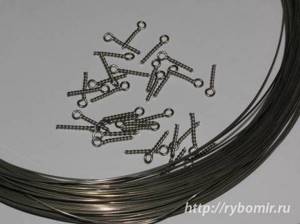
Painting consists of several stages. First, the workpiece must be coated with white paint. For these purposes, you can use an airbrush or acrylic aerosols. The latter can be bought at a hardware store.
After the white color, the workpiece needs to be opened with a brighter shade, in this case it is yellow.
Further, if you need to create stripes, you can apply a mesh to the jerk and so on. It is advisable to paint the lower part bright red, so the predator will react better to the bait.
The eyes are drawn with a brush or the tip of a stick. First you need to put a drop of yellow color, and then drop black paint inside it, this will be the pupil. To make the bait even more realistic, you can decorate it with sparkles.
Finally, several layers of varnish are applied, each new layer must be applied after the previous one has completely dried. A minimum of 5-6 layers of varnish should be applied to the bait.
That's all, the bait is ready. If assembled correctly, such a jerk will have a play with a deviation amplitude of about 20-30 cm.
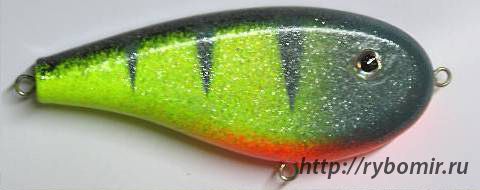
Source
Become the author of the site, publish your own articles, descriptions of homemade products and pay for the text. Read more here.
Jerkbait: not as difficult as it seems.
In most European countries, significant changes have occurred in the fishing of large predatory fish over the past decade. One might even say that we have witnessed the advent of a new era, the emergence of new approaches and a rethinking of the entire theory of predator catching. If just a few years ago in Europe the fashion for delicate gear and small artificial baits, which were used to catch almost all types of predatory fish, dominated in Europe, today a new fashion that came to us from the West is rapidly winning the hearts and thoughts of fishermen. However, in fact, this approach is far from new and has long been cultivated overseas, becoming an entire industry there with its own principles and traditions. This is a battle-tested fishing technique that allows you to catch really large predators.
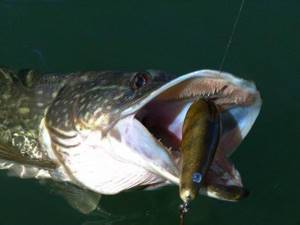
New fashion - old traditions The fashion for jerkbaits and casting tackle came to Europe in the second half of the nineties thanks to the efforts of several Dutch anglers and especially Bertus Rosemaer, a famous predator fisherman from the country of tulips. He first described this method and baits in one of the popular European fishing magazines back in 1995. Soon the pages of the European press were filled with photographs of huge predators caught on the deadly American Suicki and Reef Hawgi baits. However, despite the impressive confirmation of their catchability, jerkbaits had little chance of gaining permanent registration in Europe for one simple reason - almost all baits were brought for a lot of money from overseas, mainly from the famous Rollie & Helen's Musky Shop supermarket, located in Wisconsin . This situation in no way contributed to the popularization of jerking in Europe, and only in 2000, at the EFTTEX exhibition held in Lyon, the Polish company Salmo was the first to present European jerkbaits - Fatso-14 and Jack-18. These lures were so different from American jerkbaits that they immediately received positive reviews and won the respect of anglers. Over time, new models were added to them - Warrior and, finally, Slider, which is still the unsurpassed sales leader in Europe. Other bait manufacturers have responded very quickly to this trend in the market. Every year more and more new baits belonging to this group appear. Basically, these are more or less successful copies of already existing baits. The fascination of European fishermen with large artificial baits also played into the hands of fishing tackle sellers, who, in addition to the baits themselves, now began to sell illicit goods in the form of heavy and powerful spinning rods and reels, which previously were not in great demand. Over the course of several centuries of fishing development, optimal gear has been developed for each of the currently existing fishing techniques and types of bait. Due to the advent of new materials, some of them are still evolving, but in the case of jerking there have been no noticeable changes, the best storage for line was and remains a baitcasting reel, it is most convenient to cast and fish with a short, stiff rod.
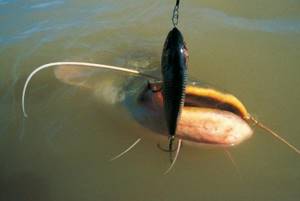
The new fishing technique , Jerking, undoubtedly opens up completely new opportunities for anglers. However, those anglers who have not yet encountered jerkbaits have many questions: why are these strange bladeless wobblers so popular? Why bother with a baitcasting reel when it is much easier to use a classic spinning reel? It is difficult to answer them briefly. In fact, you need to try this method yourself to fully understand it. Even the first experience of using baitcasting gear can turn a distrustful grumbler into a fan of a new method of fishing. Using a short and stiff rod will convince you that casting heavy baits is quite easy. Anyone for whom fishing is more than just throwing bait in and out of the water will also quickly appreciate the benefits of a baitcasting reel. The new impressions associated with mastering this fishing technique can be so strong that some anglers begin to think, and sometimes, contrary to logic, to openly talk about completely abandoning the classic spinning rod, which, in my opinion, is still a bit of an exaggeration. This reaction from anglers is partly due to the incredible control over the action of the bait when using a baitcasting reel, it is so full and natural that it seems like the line is wrapped in the palm of your hand. The greatest advantage of this gear is its convenience and simplicity, the ability to work intensively and dynamically for many hours. But to fully appreciate the capabilities of jerkbaits, you need to be creative in how you fish them. The more control you have over the bait, the more noticeable your results will be. To better understand the advantages of baitcasting gear for fishing with jerkbaits, let’s briefly go through all its elements.
Rod It is quite obvious that the majority of anglers, before using jerkbaits, used rods 2.4–2.7 m long, and sometimes longer. They fished quite successfully and believed that they simply did not need any other equipment. Perhaps this is true. You can even fish with a three-meter fishing rod from under the ice. But why?
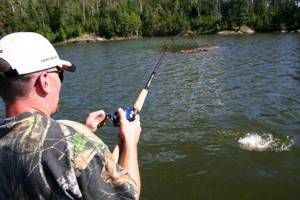
Reel and line When fishing with heavy lures, a classic spinning reel creates considerable problems due to the need to constantly grab and hold the line with your finger while casting. After several hours of such exercises, even the hardened phalanges of your fingers will have a pale appearance. In a baitcasting reel, the spool is released before casting by lightly pressing the button with your thumb, and in order to send the bait flying, you simply need to release the spool. The next advantage of a baitcasting reel is its ability to withstand long-term dynamic loads, which are an integral part of jerkbait fishing.
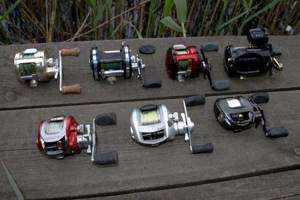
On sale you will find two main types of baitcasting reels - low profile and classic. The former have a more delicate design and are designed for fishing with small (15-35 g) baits. For “heavy artillery”, classic, round baitcasting reels are usually used. They have a more capacious spool, on which you can wind 100 or more meters of thick cord. When fishing with jerks weighing 15-35 grams, a line with a test weight of up to 10 kg (0.18 mm) is quite suitable; in this case, you can use a low-profile reel. For baits heavier than 35 g, a cord with 14-20 kg (0.23-0.27 mm) of dough is required.
Often, when they see such gear, “normal” fishermen twist their finger at their temple. The meaning of using “catfish” braid for catching pike is unclear to the uninitiated. In fact, such a powerful fishing line is necessary not only for fighting large fish. The reason for its use lies in the fishing technique itself. Jerking, in fact, is very vaguely reminiscent of ordinary spinning fishing. The big advantage of this method is the ability to fish places overgrown with aquatic vegetation and reeds. Usually, in case of a snag, we try to release the bait with one jerk. Over time, as a result of such actions, even a fairly strong fishing line will sooner or later weaken. Therefore, we need a certain margin of safety, which will allow us to fish relatively calmly, without fear that the cord will burst when biting a small fish. Anyone who has ever tried to fish for several hours contrary to this rule, after losing several expensive baits, changed his views. This applies even to a line with a breaking load of up to 20 kg, on which after several hours of fishing it is necessary to tie the knot. Just in case.
The last, but not least important element of the tackle is the leash. Unfortunately, now the fishing market is flooded with all sorts of lead junk. Tests and values indicated on bright packages with leashes of dubious quality often do not correspond to reality. How to protect yourself from poor quality leashes? The easiest way is to attach the leash to the cord you want to use. Then you just need to load the already tied tackle as much as possible according to the test indicated on the package. The weakest point should be the knot connecting the cord to the swivel. You shouldn’t be too surprised if, after your testing experiments, the weakest point turns out to be the leash at the point where it connects with the clasp or swivel. Therefore, do not make the fate of your future trophies dependent on the conscience of manufacturers of all kinds of leashes and leash materials. Make your own leashes from powerful fluorocarbon fishing line with a diameter of 0.6-0.7 mm, as I do.
Obviously, information about the use and proper configuration of gear is not all the attributes of casting. The next step in this mystery, undoubtedly, is mastering the casting technique. And once you master it, you will be able to catch fish that were previously beyond your imagination. I have repeatedly witnessed and confirmed from my own experience the much greater catchability of jerkbaits compared to other classic lures - spinners, spinners or wobblers. Why does this happen and what can be done to catch predators that do not want to respond to other baits? You will learn about this in the next part.
Most anglers do not think about what group or species the bait they are fishing with belongs to. And this is correct, because they do not need knowledge of special nomenclature - the main thing is that their bait catches fish. However, over the past decades, so many types and types of artificial baits have appeared and continue to appear that attempts to classify and systematize them seem absolutely justified. The main reason why you need to know which group the manufacturer classifies this or that bait in is the desire to get an answer to the question of how to catch fish with it and, accordingly, how to make the most of the capabilities of this bait. In most European countries, this topic is covered rather modestly. Many anglers buy into the advertising promises of tackle dealers and try to fish in ways that are completely unsuitable for bait, which brings them offensive disappointment. Here it would be appropriate to recall one story told to me by my friend from Holland, Bertus Rosemeier. So, he was once sailing on a boat and observed an amazing picture. In a boat anchored not far from the shore, a fisherman sat and, leaning his rod on the side, carefully watched a floating wobbler Salmo Perch 12F, tied on a short fishing line, dangling on the waves. To the question “How’s the bite?”, he replied that he was completely disappointed in Salmo lures. “They just write about how catchy they are, but I’ve been sitting here for an hour and no results!” – the fisherman was indignant. This is, of course, an atypical case, which, however, perfectly illustrates a complete misunderstanding of the purpose of bait. To be fair, it should be noted that this incident occurred several years ago, although even now such embarrassments still occur from time to time, and not only in Holland. Many fishermen today nod their heads in disbelief when you tell them about a simple technique for using wobblers, which increases their catchability many times over.
Amazing wobblers without blades, or jerkbaits In fact, the jerkbait family includes not only bladeless baits. The name of this group of lures comes from the fishing technique, and not from their design features. To jerk translated from English means “to pull.” This is a short and succinct description of the method. You can “jerk” not only with jerks, but also with wobblers, silicone baits and even good old oscillating spoons. However, each of the listed baits, subject to monotonous wiring, still has its own game. A classic jerkbait, without intensive work with a rod and reel, behaves like a stake in the water. Only the fisherman's meaningful actions will awaken in him the dormant secret forces that can lure the pike of your dreams from the depths. In waters where anglers primarily use small to medium-sized spinners and silicone lures, fishing with jerkbaits will be extremely successful. I was convinced of this personally during several large spinning competitions, and the same assumption was also confirmed by those anglers who were not disappointed in jerkbaits after the first failures. The most positive quality of jerk is that almost every model sooner or later reveals to the angler a new fishing technique that is successful for a particular body of water. Each jerkbait, even of the same type, has, albeit minor, differences when moving in the water - it’s like a new chapter of an exciting story, the pages of which we write with our own hands on every fishing trip. In the simple structure and action of the bait one can see some kind of primitive, magical power that forces one to concentrate and awakens the imagination. Have you ever tried to imagine what the first artificial baits might have looked like?

The first artificial baits What could they be made of? Made of wood? Feathers or bones? Or maybe from shells? We will never know for sure. After visiting the world's third largest fishing tackle museum, located in the American city of Rochester, Minnesota, one vision haunted me for a long time. In this museum, along with thousands of other incredibly interesting exhibits, I saw the so-called teaser's - ancient baits. Actually, these were imitations of fish or cephalopods, which are still used in marine fishing to attract large predators. Most often they are made of colored and very shiny artificial materials. The fishing technique for them involves fast trolling, as a result of which the teasers lure tuna and marlin to the surface. Then the boat captain skillfully reels in the fishing line, luring the predator closer to the boat, after which the fishermen try to catch the fish with their usual bait - live bait, a wobbler or a streamer with a fly rod. The teasers seen in Rochester were made slightly differently. These were quite primitive imitations of fish, carved from wood and painted. However, they were used to lure freshwater fish, mainly pike and muskie. Such a teaser was pulled behind the boat on a long line, close to the surface of the water. When a predator interested in the bait surfaced, the line with the teaser was pulled to the distance of a bow shot or a dart throw. One of the museum teasers aroused my keen interest. It was a carefully carved wooden imitation of a pike, 70 cm long! It turned out that this sample was used to lure sturgeon. Looking at the next baits, I imagined this scene through the prism of years. So, a canoe floats along the slightly rippling surface of Rainy Lake on the border of Canada and the United States, and in it...

An Indian from the Oyibwe tribe named O-Jerk, who decided to catch a couple of pikes for his dogs for dinner. He was not very respected in the tribe due to his frivolous attitude towards his tribal responsibilities. Instead of hunting buffalo or scalping his enemies, O-Jerk preferred to spend most of his time on the lake. So he swam slowly, dragging behind his canoe a freshly cut fisher in the shape of a pike perch. Suddenly, the water mirror became agitated and the ridge of a huge mask appeared on the surface, which swam after the bait, looking closely at this unusual thing. The Indian quickly put down his oar and began to reel in the line, holding it up and looking over his shoulder at the dart lying next to him. Long ago he noticed that it was precisely this uneven play of the teaser that made it possible to lure the predator all the way to the boat. This mask, however, was different from all the previous ones that O-Jerk had managed to obtain. Firstly, he was much larger, and secondly, he was very hungry. After another jerk of the line, when the teaser finished moving along a long arc, a huge fish swallowed it and, raising a fountain of spray, disappeared into the depths. The Indian did not know what to do - the forest was disappearing into the water with incredible speed behind a mask as huge as a tree. “Oh, Mother of all masks!” the Indian begged. “Give me my teaser, because I spent two whole moons making it, and if I lose it, my dogs will go to bed hungry!” However, the mask did not listen to his lamentations. Dragged O-Jerk along with his canoe until he floated under the roots of a submerged tree. Now the canoe could no longer follow him. The mother of all masks tore the remains of the wicker line from the hands of the Indian, tearing them to the point of blood, and with the last jerk dragged the precious bait into the depths. O-Jerk thought about this adventure for a long time and decided to catch the Mother of all masks in order to take his teaser from her. He knew that this was not an easy matter, so he went to the shaman for advice. He left his wigwam at dawn, after smoking twelve pipes of truth. His face was calm and impenetrable, because he knew what to do. First, he wove five times as much line so that the big mask could swim as long as he wanted. Secondly, I cut a reel out of wood to reel in this line. Thirdly, he attached this reel to a short and strong stick with loops for the line, thanks to which he could maneuver more freely while chasing fish, so as not to get caught on an underwater obstacle. In addition, this rod allowed him to control the bait more skillfully and protected his hands from the line. And finally, our hero attached bone hooks to the bait, thanks to which the likelihood of the successful completion of his enterprise increased significantly. Over time, he also noticed that the reel attached to the rod allowed him to cast the bait rather than just pull it behind the canoe. After that, he set about improving it. After some time, his fellow tribesmen gave him a new name - Jerk-O-Pay, or “He-Who-Bes-Paid-Jerky.” From each fishing trip he brought back so many pikes, muskies and even lake trout that all the dogs of the Oyibwe tribe never went to bed hungry, and his tipi was filled with the voices of five wives who wove his fishing lines and cut out baits. Could this be what the birth of the jerkbait looked like? I think yes! Couldn’t these thoughts have occurred to the natives of Karelia, the recognized cradle of wobblers? Or maybe the first jerks appeared in Poland? But there is no legend without exaggeration! And I would also doubt it if it weren’t for the story told to me in 1983, after demonstrating my wobblers to an old fisherman from the small village of Bukovo, on the Baltic coast. He recalled that even when he was a child, his grandfather used to catch large pikes and pike-perch on the Baltic coastline with such “wooden fish, only much larger in size.” Here's the story! We will probably never know the truth about the birth of the jerkbait, but that’s not the main thing. The main thing is that, despite its rather primitive design and not very sophisticated appearance, it regularly catches large fish on both sides of the Atlantic, often leaving behind shiny spinners and realistic silicone baits. “Suick”, Musky Mania “Burt”, Fudally “Reef Hawg”, Salmo “Jack”.
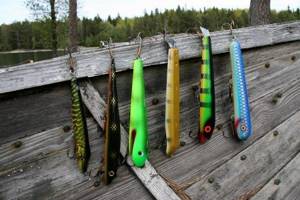
The monotonous wiring of these baits will not make them even move. Therefore, many fishermen, after the first casts, hastily classify them as useless fishing souvenirs, which they catch somewhere there, in America, but not here. Absolute nonsense! Each of these types of bait caught an incredible amount of pike. I think that the secret of their success lies in the perfect imitation of the movements of small pike. Each of you, I think, has seen more than once what characterizes these movements. This is more reminiscent of throwing forward or to the side than “normal” fish movement. This is exactly how our bait should be presented to the pike. Due to the absence of a blade on these jerks, the resistance during their wiring is minimal. Therefore, it is very important for the angler to be concentrated while fishing and constantly monitor the operation of the bait. This feature can be seen very well in the example of such “classics of the species” as Suick, Burt or Salmo Jack. Even a slight movement of the rod causes a long glide of the bait towards the angler, which at the same time rolls from side to side, demonstrating a characteristic zigzag movement.
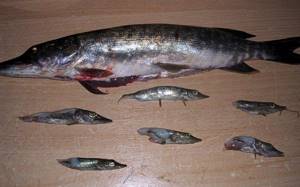
Introducing the fishing technique with these baits, I should draw your attention to the different approach to the use of sinking and floating models. Floating jerkbaits are used at depths from 0.5 to 3 m, and sinking ones - from 2 to 5 meters. Let's look at the fishing technique using the Jack-18 model from Salmo as an example. After casting, we deepen the bait with several smooth pulls. Their number depends on the depth of the reservoir. Jack reaches his maximum diving depth, about a meter, after two or three stretches. Consequently, at a depth of half a meter, one movement of the rod will be enough, after which the bait can even be allowed to float to the surface. The length of the pull should also depend on the depth at the fishing spot. Maximum diving of the bait can be achieved by working the rod in the range from hip level to the surface of the water. It happens that sometimes in order to remove the bait from the reeds or accurately move it between aquatic vegetation located on the surface, it is necessary to lift the tip of the rod upward, working it above the surface of the water. Next, as the depth increases, we lower the tip closer to the water. After each stretch, Jack dives and swims for some time, turning slightly from side to side or floating to the surface, and when stopping, he freezes with his head up, slightly waddling from side to side. If the average depth at the fishing spot exceeds 2 meters, it is better to use sinking versions of jerkbaits. The work of a sinking Jack is somewhat different than a floating one. It glides forward somewhat sharper, but at the moment of “hovering” it behaves almost the same as a floating one, with the only difference being that when it stops, it slightly waddles from side to side and slowly sinks. This works on a large pike like a matador's red cape on a bull.

If you are fishing close to the shore, where the bottom drops sharply under the boat to a depth of 4-5 meters, you must definitely use the fact that your bait is sinking. After casting, we wait until it reaches the appropriate depth, and begin a series of long, smooth pulls, alternating with stops, during which our bait will slowly sink. Everyone knows what an excellent place for pike sites the underwater walls at the edge of the reeds are. If it is not too thick, you should take a chance and send the bait further into the reeds and wait a couple of seconds. After this, we begin twitching with the tip of the spinning rod directed upward. After the bait comes out of the reeds, we gradually lower the tip of the rod, thereby giving Jack the opportunity to dive deeper. A very successful and proven action is to strengthen your arsenal of twitches and pulls with a smooth movement of the hand, which ends each movement of the bait - a kind of “finishing off”. Usually, each movement of the rod is performed using the entire hand - from palm to shoulder, but it is this last “strokes” of the hand that gives the bait agility and liveliness. This technique is effective when using both versions of Jack. The use of this bait also requires the angler to be able to control the tension of the fishing line.

Therefore, we can conclude that successful fishing with classic jerkbaits such as Salmo Jack, Burt, Reef Hawg or Suick depends on perfect mastery of synchronized rod and reel action to avoid slack line. This is perhaps the most difficult moment in the “maintenance” of your bait, but do not forget that the work invested in this science will pay off handsomely in the future. You need to suffer a little in order to be rewarded for this torment one fine day by seeing a huge mouth closing over your jerk in a place where you have never caught pike larger than 1-2 kilograms before.

The next group includes lures that do not require sharp jerks with the rod when retrieving. In order to get the desired effect, you need to make smooth and not too long pulls with the tip of the rod. These baits belong to the group of jerkbaits under the general name pullbaits.

Pullbaits An example would be the Swedish Zalt pullbaits, the American Beliver or the Polish Salmo Fatso and Warrior.
Peter Piskorski
LiveInternetLiveInternet
Continuation…
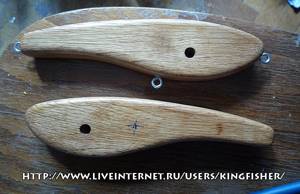
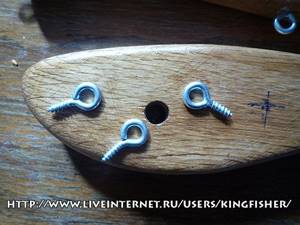
In the absence of a suitable drill, I drilled holes for the rings with a bitten nail.

The shape of the jerks turned out to be slightly similar to the buster jerk from Strike Pro, and I decided to borrow the loading system from them. In the photograph of a transparent jerkbait buster jerk, found on the forum of the website jerkbait.ru, the loading system is clearly visible and holes were drilled in its likeness in homemade baits.
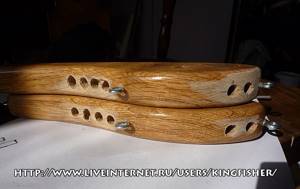
Before all actions, the wooden blanks were coated 2 times with Tikkurilov yacht varnish diluted half with white spirit and thoroughly dried. I decided not to pour the filler (lead) into the holes, but to cast it separately and hammer it into the holes.
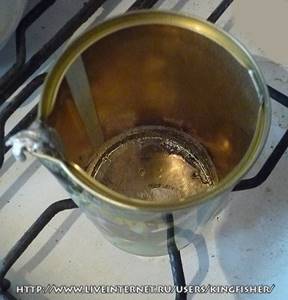
With the drill that I used to drill holes in the baits, I drilled a through hole in a frozen (dry) piece of alabaster and poured molten lead there.

Thus, after 10 minutes I had about a dozen straight lead rods of the same diameter as the holes for loading in the baits.

While the bathtub was filling with water, I decided to make rattles - place balls in the holes that were originally in the piece of wood and seal them with tin rounds. I decided to use plastic balls from vodka bubblers as acoustic balls.
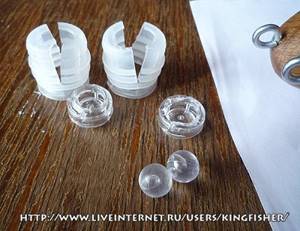
Only they turned out to be not small - the holes had to be greatly expanded.
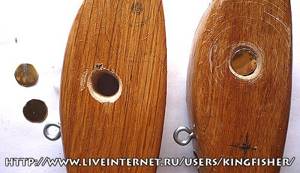
From a can in which lead was melted, I cut out four tin rounds and inserted the balls inside and sealed the holes on the sides with these rounds. I glued it with instant glue called “Crazy Hands”..
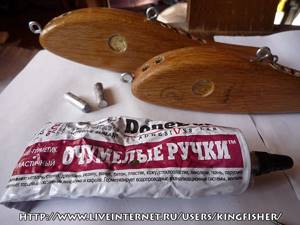
Since the bathtub was already filled, and the glue had not yet completely dried, I additionally coated the round pieces with plasticine and hung suitable tees on the bait rings and began loading.
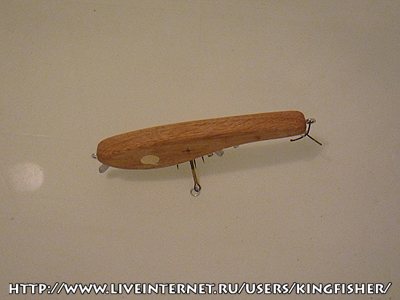

Having achieved the desired result, the lead rods were driven into the body of the baits with a hammer blow,

the holes were filled with epoxy and sawdust, and ring-screws were placed on it for strength. Having marked the sinking jerk (for later DIFFERENT coloring), both baits were coated with acrylic primer and then painted in two coats of acrylic white.
